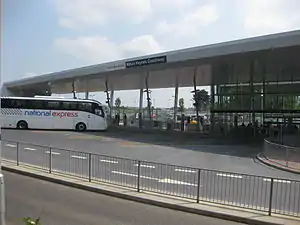Coachway interchange
A coachway interchange (also transitway station, busway station) is a stopping place for express coach services near the trunk road/motorway road network. It relies on available local transport modes to complete individual journeys. Coachway interchanges help to achieve low overall journey times by avoiding operation through congested urban centres.[1][2]
History
United Kingdom
The Milton Keynes Coachway was the first to be called a coachway and has been in operation since 1989.[3][4]
Alan Storkey, a transport economist, proposed a motorway based coach system based on Coachway interchanges to the House of Commons Transport Select Committee in May 2006[5] and was promoted by George Monbiot in 2006.[6]
The South East England regional assembly gave support to the High Wycombe Coachway in December 2009.[7]
In January 2010, the South East England regional transport board criticised the plans published by the development authority for the 2012 Summer Olympics for not providing plans of a credible long term coach network saying 'The ODA has been working on an extensive network of coach services... [but] the lack of reference to this work [in the plan] is both intriguing and at the same time concerning.'[8]
Coachway stations in service
United Kingdom

- Milton Keynes Coachway (near M1 Junction 14), in operation since 1989, is the UK's second busiest coach station.[9][10] Its parking facility doubles as the local Park and Ride.
- Meadowhall Interchange (near M1 Junction 34) serves Sheffield.
- The Hard Interchange (at the end of the M275) serves Portsmouth.
- The Ferrytoll park and ride in south Fife is an important intermediate stop for many coach services between Edinburgh, Fife and the rest of Scotland.
- High Wycombe Coachway opened near Junction 4 of the M40 in January 2016.[11]
Other coachway interchanges are less formal. The Reading Coachway on the M4 motorway is more like a bus stop in a supermarket car park.
See also
- Coach transport in the United Kingdom
- Victoria Coach Station in central London is the UK's busiest and had been in operation since 1932.
- Bus rapid transit (A general article about bus rapid transport - similar issues for coach rapid transport)
References
- "Milton Keynes East - Coachway". Milton Keynes Partnership. Archived from the original on 14 February 2010. Retrieved 30 January 2010.
- "Issue 293". Oxford and Chiltern Bus Page. Retrieved 29 January 2010.
A coachway is defined as a coach station built adjacent to a motorway interchange to allow regional coach services to serve the local area while allowing the integration of local feeder services serving the adjoining urban and rural areas. This will enable residents of the area to have access to existing regional coach services and also to potential new services. It is our aspiration that the coachway facility will enable local residents to access a regional coach network, with services to Oxford and London, to the Thames Valley and potentially north of High Wycombe. Access to key facilities such as airports is also expected to be improved
- First coaches from the new coachway, April 1989
- The coachway first appears on the '1990 Official City Map of Milton Keynes' (pub. Milton Keynes Development Corporation in late 1989).
- "Transport Committee Inquiry into Bus Services across the UK". Parliament. Retrieved 30 January 2010.
- Monbiot, George (6 December 1996). "I'm all for putting more vehicles on our roads. As long as they're coaches". The Guardian. London. Retrieved 30 January 2010.
- "Planning application for a coachway park and ride, business and hotel development". Wycombe District Council. 24 December 2009. Retrieved 29 January 2010.
- "ODA plays down South East's fears about Olympic legacy coach network". Local Transport Today. 22 January 2010. Retrieved 30 January 2010.
- After Victoria Coach Station
- "Building the new Milton Keynes Coach Station". Milton Keynes Council. Archived from the original on 30 November 2010. Retrieved 20 January 2010.
- "Opening Report". Bucks Free Press. 15 January 2016. Retrieved 24 January 2016.